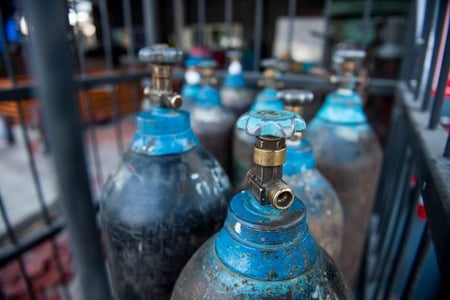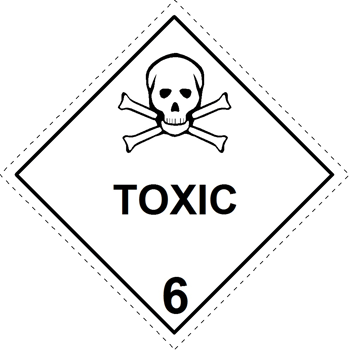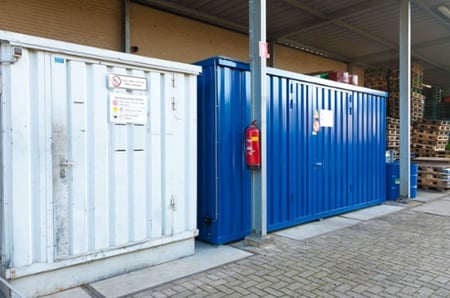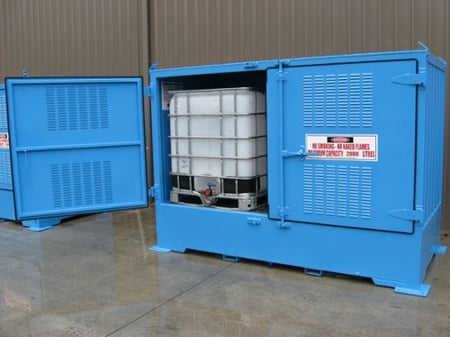Most businesses that use hazardous chemicals in their daily operations won’t carry just one particular class of dangerous goods. Instead, many workplaces must navigate safety regulations when handling and storing mixed classes of dangerous goods in their workplace. But what risks are posed when you’re holding several classes of chemicals onsite — and how do you ensure that your people, property and environment remain safe?
In this short blog series, we’ll be looking at how to safely store mixed classes of dangerous goods — specifically, larger quantities of goods in the outdoor environment. We’ll be explaining the difference between incompatible substances and those which can react dangerously with each other. We’ll also be detailing the hazards associated with carrying mixed classes of dangerous goods — and the importance of chemical segregation.
But first, let’s kick off this article by detailing the 9 chemical classes (many of which you may already have at your own worksite).
Classes of Dangerous Goods
There are 9 different classes of dangerous goods, and many of these classes have divisions that detail further sub-categories of hazardous chemicals. These are:
Class 1: Explosives
This DG class presents a significant danger to the organisations that carry these goods. Class 1 Explosives are categorised within 6 divisions, with the most hazardous Division 1.1: substances and articles which have a mass explosion hazard to Division 1.6: extremely insensitive articles which do not have a mass explosion hazard.
Class 2: Gases
While you may not always think about your gas bottle as being a dangerous good, many everyday gases used in the workplace fall into the Class 2 category. Within this DG class there are multiple divisions for flammable, non-flammable and non-toxic, and toxic gases.

Gases are divided into those which are flammable, toxic or non-flammable and non-toxic.
Class 3: Flammable and Combustible Liquids
This commonly found class of chemicals includes flammable and combustible liquids, such as petrol, oil, solvents and acetone. They are recognised for their ability to ignite or combust in the presence of an ignition source. These liquids are particularly volatile due to their low flashpoint – which means that they can potentially ignite at temperatures often found in work environments.
Class 4: Flammable Solids
There are three divisions within the Class 4 category, including Division 4.1 Flammable solids, self-reactive substances, polymerizing substances and solid desensitised explosives; Division 4.2 Substances liable to spontaneous combustion; and Division 4.3 Substances which, in contact with water, emit flammable gases (known as dangerous when wet).
Class 5: Oxidizing Substances and Organic Peroxides
Division 5.1 Oxidizing substances are recognised as a chemical that oxidizes with another substance, which Division 5.2 Organic peroxides are thermally unstable organic substances that are formed with two oxygen atoms joined together.
Class 6: Toxic and Infectious Substances
A chemical class commonly found in workplaces and laboratories, Division 6.1 Toxic Substances and Division 6.2 Infectious Substances pose serious risk to human health and require specific hazard controls that prohibit inhalation, ingestion or contact with the eyes or skin.
 Toxic substances are Class 6 chemicals, which means they pose a threat to human health.
Toxic substances are Class 6 chemicals, which means they pose a threat to human health.
Class 7: Radioactive Material
The dangerous goods within the Class 7 Radioactive Material category are those materials which emit radiation. Due to the extremely high level of risk involved, radioactive materials are subject to strict regulations for the handling, storage and disposal of these chemicals.
Class 8: Corrosive Substances
With the ability to damage living tissue, metal and other materials, Class 8 Corrosive Substances are a chemical class comprised of acids and bases. Corrosive substances are widely used in homes and workplaces as cleaning products, drain cleaners and degreasers.
Class 9: Miscellaneous Dangerous Substances and Articles
This DG class encompasses a wide range of substances and articles from lithium-ion batteries to asbestos and automotive airbags.
IMPORTANT: Your Safety Data Sheet (SDS), along with the requirements specified in the relevant Australian Standard, should form the basis of your storage and handling procedures. If you are carrying Class 9 substances and articles, and there is no SDS, refer to the manufacturer’s instructions on how to store and handle these items.
Outdoor Chemical Storage
Due to restrictions placed on indoor chemical storage — including the maximum capacity for indoor safety cabinets — many organisations choose to store their dangerous goods in the outdoor environment.

Outdoor chemical storage is often a more practical option for businesses carrying larger quantities of dangerous goods.
However, storing large volumes of hazardous chemicals can increase the impact of incidents, such as spillage and vapour emissions. For example, imagine an IBC (filled with flammable liquids) being relocated with a forklift. During the work task, the forklift jolts and drops the IBC onto the concrete floor of the outdoor work area. The Class 3 chemical spill would saturate a range of surfaces and equipment including the forklift, the ground, nearby stores, handling areas and even the skin, eyes or clothing of nearby staff.
Now consider that there are multiple classes of dangerous goods being stored or used in the same area. In the event of a leak or spill, how would you ensure that your flammable liquid spillage did not affect other dangerous goods nearby? Class 3 Flammable Liquids are classed as incompatible with most chemical classes — and can cause safety issues for organisations that don’t adhere to the segregation requirements.
What Hazards Are Associated With Storing Mixed Classes Of Chemicals?
As we’ve explained in the earlier section of this blog, there are 9 classes of dangerous goods that you may find in the workplace. When looking at the hazards posed with each class of chemical, you must also consider the issue of chemical incompatibility.
The Australian Standard AS 3833 - The storage and handling of mixed classes of dangerous goods, offers definitions for substances which are ‘incompatible’ and those that ‘react dangerously’.
Incompatible substances are defined as:
1.4.26 Incompatible
In relation to dangerous goods or other goods, goods that are—
(a) likely to interact with the dangerous goods so as to increase the risk when mixed or otherwise brought into contact with the dangerous goods;
(b) listed in the ADG Code/NZS 5433 as being incompatible; or
(c) declared by the regulatory authority as being incompatible. In relation to packaging or transfer equipment, a container or item of equipment that is constructed of material likely to interact with the dangerous goods such that it is weakened or damaged to the extent that risk increases.
However, chemicals which product a dangerous reaction are defined in the Australian Standard as:
1.4.48 React dangerously
In relation to the reaction of substances, to react in a manner that directly creates a hazard due to the reaction—
(a) being violent;
(b) producing an explosion;
(c) producing a potentially explosive combination of products; (d) producing fire or rapid evolution of heat; or
(e) producing toxic vapour or toxic gas.
Whether your dangerous goods are recognised as incompatible, or they are capable of creating serious hazards and fatalities due to a reaction of chemical substances, you must ensure that your chemicals are handled and stored in a way that reduces risk.
IMPORTANT: When handling or storing mixed classes of dangerous goods, refer to the Australian Standard AS 3833 for detailed guidance on how to manage these goods safely in your organisation.
Reducing Chemical Risk
If incompatible substances come into contact with each other during the handling, transferring or storage process, there is an increased risk to your organisation. Similarly, if you are carrying dangerous goods that are capable of reacting dangerously with other substances, you could be putting your organisation at risk of a violent chemical reaction, a fire, an explosion, or even the emission of toxic vapours and gases.
However, while these risks may be concerning, you should keep in mind that most businesses safely store mixed classes of dangerous chemicals – without it ever resulting in a hazard or serious incident.
So, what are the measures that you need to take to ensure that your mixed classes of chemicals are handled and stored in a way that reduces the risk of incompatibility or dangerous chemical reactions?
Practice The Correct DG Segregation Rules
While we strongly suggest conducting an onsite risk assessment (which will refer to the individual chemical SDS as well as the relevant Australian Standards), there are some simple segregation rules that you can follow to reduce risk when handling and storing multiple classes of dangerous goods.
The DG segregation rules have been created to provide specific guidance around the required distances between chemical stores. By listing distances for each class of chemicals, organisations can safely handle and store their chemicals apart from any other incompatible substances.
What Chemicals Should Be Segregated?
Most dangerous goods classes are incompatible with many other classes and require strict segregation in the workplace.
For example, flammable liquids must be distanced from incompatible substances by at least 3 or 5 metres (depending on the other class of chemicals kept nearby). Your flammable liquids store must only house other Class 3 liquids.
Best Storage For Multiple Classes Of Dangerous Goods
As a general rule, you should never store mixed classes of chemicals in the same store.
The best practice for dangerous goods storage, is to select a compliant outdoor chemical storage container to house a particular class of dangerous goods.
Each compliant container, such as a dangerous goods outdoor store, will be fully equipped with the appropriate risk control measures that are required for that specific chemical class.
These may include:
- Liquid-tight spill containment
- Natural ventilation for the dispersion of hazardous vapours
- Sheet steel construction for weather and impact protection
In addition to these control measures, your container will also provide chemical segregation from other nearby stores. This is due to the durable sheet steel construction of the compliant chemical storage container.
This is particularly useful for businesses that don’t have ample outdoor space — and may not be able to follow the dangerous goods segregation rules. However, we always suggest leaving as much possible space between containers that house different classes of dangerous goods. Therefore, if there is an incident, such as a flammable liquids spill, there is less chance that the chemical will mix with or come near the other incompatible substances held onsite.
Choosing compliant storage reduces the risk of incompatible substances coming into contact with each other.
Safe Outdoor Dangerous Goods Storage
Thanks for reading Part 1 in our short blog series on storing mixed classes of dangerous goods in the outdoor environment. In Part 2, we’ll be explaining the specific requirements regarding the handling and storage of mixed classes of chemicals.
To find out more about successful chemical segregation, we invite you to download our free eBook. Our guide will help you determine your storage requirements and reduce chemical hazards in your workplace.
Joining the team as a Dangerous Goods Storage Consultant, Melissa Hampton became Storemasta's Marketing Manager in late 2021. With extensive knowledge and experience in chemical compliance, Melissa is responsible for leading the Marketing team and helping shape their marketing strategy. In her spare time, you can find Melissa hiking, swimming and enjoying the great outdoors in beautiful north-west Tasmania.

